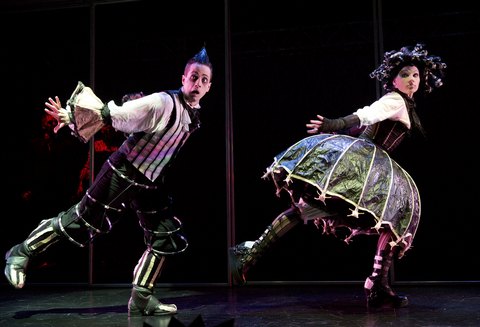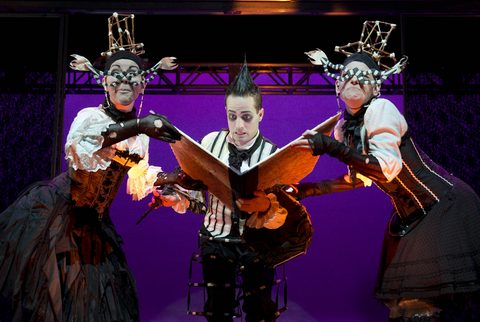Nevermore: The Imaginary Life and Mysterious Death of Edgar Allan Poe
A natural for fans of either steampunk or Poe, but the great visuals can’t overcome canned backing tracks and a monotonous score.

Scott Shpeley and Shannon Blanchet in a scene from Jonathan Christenson’s “Nevermore” (Photo credit: Joan Marcus)
[avatar user=”Eric Grunin” size=”96″ align=”left”] Eric Grunin, Critic[/avatar] Nevermore, a pop operetta written, composed and directed by Jonathan Christenson, presents us with a biography of Edgar Allan Poe. The mostly sung-through piece is given visual delight by production designer Bretta Gerecke via a steampunk-inspired amalgam of styles: punk hair, goth makeup, and Victorian corsets, to which are added fanciful skirts and hats which appear to have been made from found objects. (Gerecke is responsible for sets, costumes, and lighting.) The cast of seven, featuring Scott Shpeley as Poe himself, are all excellent, dedicated and imaginative. Christenson’s direction works hand-in-glove with Laura Krewski’s choreography, all movement so thoughtfully and consistently stylized that it’s both acting and dancing at every instant. It’s subtitled The Imaginary Life and Mysterious Death of Edgar Allan Poe, and that life is outlined well.
His sad story is almost absurd in its piling on of one tragedy after another. Those carried off by tuberculosis included his mother, foster mother, sister, and wife; father and brother were addicted to alcohol, as was Poe himself. He died at a mere 40 years of age under circumstances that remain, indeed, mysterious. (These last days are a popular topic in fiction, and were the subject of the theater piece Red-Eye to Havre de Grace, seen last year at New York Theatre Workshop.)
Cradle-to-grave biography, though tempting, is an inherently problematic subject for the stage. Childhood is typically a semi-random parade of fortune and misfortune which tells us little about the adult who eventually proved of lasting interest; and, of course, no child can perceive the larger shape of his own life. So we typically get one of two narrative gambits, either plenty of direct address to the audience, or an end-of-life scene used as a framing device, with the story being told in flashback. Nevermore chooses the latter.
The next dramatic challenge, in this case, is that our hero is a writer. We celebrate Poe for his fantastical work, as well as his reinvention of what we now call genre fiction. Alas, literary creation is not much to look at, and giving the audience stale summaries of his tales would be little better. Nevermore takes the approach of alluding only indirectly to his stories, having him intermittently plagued by frightening birds, a filmy-blue eye, the occasional black cat, and assorted other eerie visions. One presumes these visitations are fictitious, but in any case the connection between these images to his stories is not hammered out too heavily and is the more effective for it.
In sum, anyone with a particular interest in the steampunk aesthetic or Poe will have a good time with this. For the rest of us, alas, there are obstacles to full enjoyment.

Lindsie VanWinkle, Scott Shpeley and Shannon Blanchet in a scene from Jonathan Christenson’s “Nevermore” (Photo credit: Joan Marcus)
To begin with, the music is insufficiently varied. Even in a piece whose basic tempo is slow, over the course of two hours one must find moments to raise the pulse. Harmonically there are long stretches utilizing only four chords, sometimes three. The lyrics might compensate for this, but they do not. While the rhyming is sometimes adroit, the scansion is frequently awkward, and there is little employment given to structural devices such as refrains, parallelism, and episodes of metaphoric intensity. Such shaping is optional in light poetry but obligatory in lyrics: we need milestones and rest stops as we proceed through forty-five minutes of otherwise undifferentiated couplets. (Not that this registers consciously with the audience members, who misattribute their intermission ennui to the “unrelenting woe” of the plot.)
This hits home hugely at the climax of second act, when we get a few stanzas of Poe’s masterpiece, “The Raven.” Within seconds, we are gripped and held by the sheer power of the poem as sound, not only rhyme but also rhythm, alliteration, and assonance. It gets us in the gut because here the virtually monotonous melody and obstinately repeating accompaniment are just what is needed to support the text. We don’t even mind that Christenson has fabricated a chorus with which to separate the stanzas, because it gives us needed time to absorb one verse and prepare for the next. It’s a perfect demonstration of the ebb and flow of lyrical tension that is largely missing from the rest of the score.
Finally, and most unfortunately, the synthesized accompaniment is entirely pre-recorded, to the obvious detriment of dramatic force. Time and again there are moments where the performers would benefit from the ability to press forward or pull back to make an emotional moment land, but are bound to the metronomic ticking of the track. The arrangement of the accompaniment (presumably by Matthew Skopyk, music producer) is elegant and colorful and never draws attention to itself, really a very fine job; nevertheless, the production would be incalculably better served by four hands at a baby grand, or even a barroom upright.
If any of those three problems were improved, the whole could be recommended very strongly. As it stands, however, the long evening takes flight only intermittently in spite of the interesting premise, wonderful performers and brilliant design.
Nevermore: The Imaginary Life and Mysterious Death of Edgar Allan Poe (through March 29, 2015)
New World Stages, 340 West 50th Street, in Manhattan
For tickets, call 800-447-7400 or visit http://www.nevermoreshow.com
Running time: two hours and 15 minutes including one intermission






Leave a comment